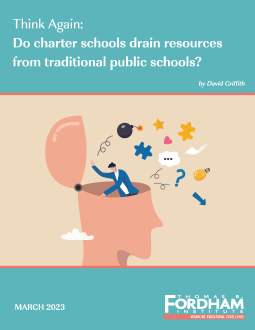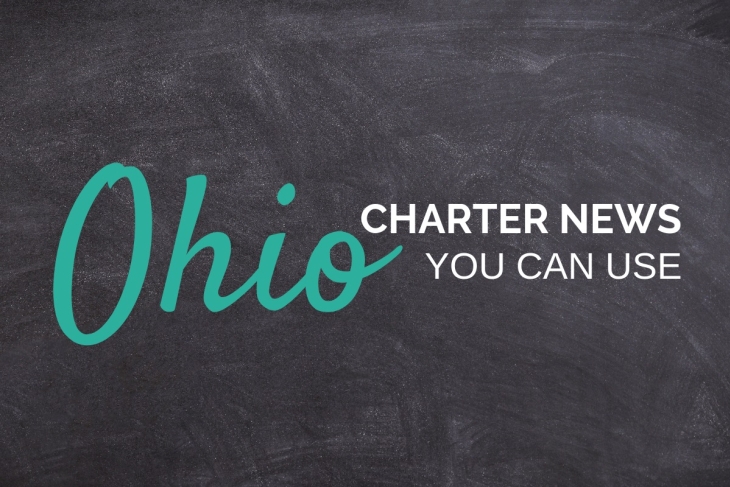Executive Summary
Q: Do charter schools increase or decrease districts’ total revenues per pupil?
A: Charter schools may increase or decrease districts’ total revenues per student, depending on who authorizes them, how they impact the local housing market, and the policies that states and localities adopt.
Q: Do charter schools increase or decrease districts’ instructional spending?
A: Competition from charters may push districts to increase or decrease their instructional spending (though it has mostly positive effects on specific instructional inputs such as teacher salaries).
Q: Do charter schools make districts more or less efficient?
A: While few studies address the efficiency question directly, what we do know suggests that charters make affected school districts more efficient, at least in the long run.
The Bottom Line
In the long run, districts will adjust to charter-driven enrollment declines, just as they do when their enrollments fluctuate for other reasons, so the challenge for policymakers is managing any transition costs—that is, any temporary fiscal or operational challenges that districts face—in a way that is fair to students and taxpayers.
Recommendations
1. Ensure that local dollars follow students to charters on an equitable basis.
2. Ensure that any compensatory funding that districts with declining enrollments receive is temporary.
3. Prioritize the needs of displaced students in cases where the consolidation of under-enrolled district schools is inevitable.
––––––––––––
Introduction
Opponents of public charter schools often claim that they drain resources from traditional public schools.[1] Yet from the standpoint of educating children, the real question is whether districts’ finances and capacity to meet students’ needs are compromised by charters’ presence.
To address that question, this brief synthesizes the latest and most rigorous research on three important subquestions: First, do charters increase or decrease districts’ total revenues per pupil? Second, do they increase or decrease districts’ instructional spending per pupil? And finally, does their presence make districts more or less efficient?
Question 1
Do charter schools increase or decrease districts’ total revenues per pupil?
Contrary to public perception, the logical implication of many local, state, and federal policies is that districts’ total revenues per pupil increase when students exit the system for charter schools. For example, in thirty-seven of the forty-six states where they exist, charters are at least partially excluded from local funding sources,[2] which account for 45 percent of total K–12 education funding. Consequently, districts’ local revenues per pupil increase mechanically insofar as students, but not the associated tax dollars, exit the district system.
As for state funding, many states have adopted “hold harmless” policies that temporarily shield school districts from the declines that would otherwise be associated with declining enrollment,[3] as well as other policies that subsidize smaller districts.[4] And a few states, such as Massachusetts[5] and New York,[6] compensate districts specifically for charter-driven enrollment losses.
Finally, although they account for just 8 percent of total K–12 education revenues, all four parts of the federal Title I program have time-limited hold harmless provisions,[7] as well as other wrinkles that could potentially benefit districts when they lose students to charters.[8]
Importantly, some research suggests that the presence of charters has reduced residential property values and, by extension, local revenues per pupil in Rust Belt states such as Michigan,[9] Ohio,[10] and Pennsylvania (where the effect was partly offset by compensatory state policy).[11] Yet other studies paint a more positive picture. For example, one Massachusetts study found that charters increased districts’ total revenues per student.[12] And while analyses of charters’ impacts in Arizona,[13] California,[14] New York,[15] Texas,[16] and Utah[17] didn’t directly examine the question of total revenues per pupil, in at least some of these cases, total spending per pupil appears to have increased.
In addition to these state-specific analyses, one national study found negligible effects on districts’ total revenues per pupil.[18] And a recent quasi-national analysis published by the Fordham Institute that focused on “independent” charters—that is, those not authorized by the “host” school district—found positive or null effects on districts’ local, state, federal, and total revenues per pupil in most of the states it considered.[19]
In short, research suggests that charter schools may increase or decrease districts’ total revenues per pupil depending on who authorizes them, how their arrival impacts the local housing market, and—perhaps most important—the policies that states and other jurisdictions adopt.
Question 2
Do charter schools increase or decrease districts’ instructional spending?
Although its precise definition varies by jurisdiction, the term “instructional spending” is generally understood to refer to the monies a school system spends on salaries and benefits for teachers and their classroom aides, as well as textbooks and other classroom materials. In other words, it is spending that is clearly related to students’ experiences in the classroom, as opposed to administration or facilities.
If the presence of charter schools were clearly associated with declines in districts’ instructional spending per pupil, critics would have a solid foundation upon which to build their case. Yet, like the research that examines charters’ effects on districts’ revenues, the research that examines their effects on districts’ instructional spending per pupil highlights the importance of state and local context, including but not limited to policies that determine districts’ total revenues per pupil. For example, the aforementioned studies of Ohio, Pennsylvania, and California all found declines in instructional spending, both in absolute terms and as a share of total spending.[20] In contrast, both an early study of charter school competition in Michigan[21] and a more recent Utah study found null effects.[22] And in Massachusetts[23] and New York City,[24] instructional spending per pupil increased.
In Fordham’s study of “independent” charters, an increase in the share of local students who enrolled in independent charters was associated with a significant increase in districts’ instructional spending per pupil in eight states. And in another twelve states, there was no significant effect in either direction (though these results don’t necessarily generalize to district-affiliated charters).[25] In other words, many of the places where research suggests an increase in total revenues per pupil may have also experienced an increase in instructional spending—or at least, no significant change—while the places where research suggests a decline in total revenues per pupil may have also experienced a decline in instructional spending.[26]
Notably, in addition to instructional spending per pupil, researchers have examined the effects that competition from charter schools has on specific instructional inputs. For example, while the Michigan study found no effects on average teacher salaries or class sizes,[27] a study of charters’ fiscal spillovers in Albany and Buffalo found that student-teacher ratios declined in district schools.[28] Similarly, while the California study found a small decline in district teachers’ salaries,[29] studies of teacher labor markets in Massachusetts,[30] North Carolina,[31] and Texas[32] reached the opposite conclusion.
In short, competition from charters may push districts to increase or decrease instructional spending per pupil depending on the circumstances, but it seems to have mostly positive effects on specific instructional inputs.
Question 3
Do charter schools make districts more or less efficient?
At the heart of the debate over charters’ fiscal spillovers is the claim that they increase districts’ fixed costs per pupil, thus making them less efficient. Yet in practice, classifying costs as “fixed” or “variable” is a slippery business. For example, districts in some states are at least theoretically required to provide services such as “textbooks, computer hardware and software, pupil transportation, pre-K services, and health services” to all resident students, including those in charters.[33] Consequently, making apples-to-apples comparisons can be challenging when it comes to spending on these items.
Because of these complexities, many studies have focused on things like higher per-pupil expenditures on building maintenance, which are often taken as evidence that district schools have become “inefficiently small.”[34] No doubt there is a grain of truth to this allegation, at least in places where district enrollment declines in absolute terms. Still, insofar as charter-driven increases in noninstructional spending are evidence of inefficiency, districts aren’t powerless. For example, after years of charter-driven enrollment losses, in 2013 the District of Columbia Public Schools consolidated fifteen chronically under-enrolled campuses,[35] while the Chicago Board of Education voted to close at least fifty school buildings.[36]
As those examples suggest, distinguishing between short- and long-run effects is critical to any discussion of districts’ fixed costs. For example, the California study mentioned above finds evidence that “districts may be more able and willing to respond to charter school competition across longer time horizons, or when competition reaches a certain threshold.”[37] Yet most studies of charters’ fiscal side effects make no real effort to explore this possibility.
Worse, by focusing on districts’ fixed costs per pupil as opposed to their return on investment, most studies implicitly discount the possibility that districts with a sizable charter presence get more bang for their buck. After all, charter schools are plausibly associated with any number of changes in districts’ organization and operation. For example, competition from charters could lead to more “inefficiently small” district schools, subsequently prompting beneficial changes to districts’ human-capital policies or operations, such as more rigorous evaluations or a more flexible pay schedule. In other words, an increase in districts’ “fixed costs per pupil” doesn’t necessarily imply a lower return on taxpayers’ investment.
Importantly, the research on charters schools’ academic impacts on district schools has become increasingly positive in recent years. For example, at least twelve studies that rely on student-level data have now found positive effects on districts’ achievement,[38] while seven others have found mixed or neutral effects,[39] and just three (increasingly outdated) studies have found effects that are unambiguously negative.[40] Similarly, some recent studies have found that competition from charters improves district students’ attendance and behavior (though there is less evidence when it comes to these outcomes).[41]
Ironically, the logical implication of these findings is that, insofar as charters are marginally reducing districts’ total revenues per pupil, they are also making them more efficient. And conversely, increases in district students’ achievement aren’t necessarily evidence of greater efficiency insofar as districts reap a fiscal windfall.
Unfortunately, research that addresses the question of return on investment is hard to come by; however, a recent study of charters’ fiscal impacts on district schools in New York State provides an intuitive starting point. On average, the authors find that charters’ arrival leads to short-term cost increase in host districts. However, this negative finding is “offset by efficiency gains in the long term” (by which the authors mean anywhere from one to eight years after a charter arrives). Consequently, districts with higher levels of charter penetration achieved “net reductions in the expenditures used to achieve a given level of outcomes.”[42]
In short, while few studies address the efficiency question directly, what we do know suggests that charters tend to make affected school districts more efficient, at least in the long run.
The Bottom Line
In the long run, districts that lose students to charter schools will adjust their behavior, much as they do in response to the inevitable changes in local demographics.[43] And with the right incentives, forward-thinking districts might adjust their behavior sooner rather than later. In other words, the challenge for policymakers is managing whatever transition costs are associated with moving to a more choice-based system in a way that is fair to students—regardless of what sort of school they attend—while also encouraging decisions that are fair to taxpayers.
In general, insulating districts from the fiscal pressures associated with enrollment declines is the wrong way to approach that challenge; however, insofar as districts are granted some sort of grace period—that is, insofar as policymakers allow their revenues per pupil to increase temporarily—the associated costs should be borne by the general public, not the disproportionately low-income and minority students whose parents or guardians choose to send them to a public charter school.
Recommendations
1. Ensure that local dollars follow students to charters on an equitable basis.
For example, California and Florida use identical funding formulas to allocate federal, state, and local funds to charter and traditional public schools.[44]
2. Ensure that any compensatory funding that districts with declining enrollments receive is temporary.
For example, Colorado funds districts based on their average enrollment over the past three years, while Nevada allows them to choose from the last two years.[45]
3. Prioritize the needs of displaced students in cases where the consolidation of under-enrolled district schools is inevitable.
For example, New Orleans’ common enrollment system prioritizes the preferences of students whose schools have closed, while local nonprofits offer information and assistance to their families.[46]
Endnotes
[2] National School Boards Association, How States Fund Charter Schools (Alexandria, VA: Center for Public Education, National School Boards Association, 2021), https://www.nsba.org/-/media/NSBA/File/cpe-charter-fund-brief-september-2021.pdf; Corey A. DeAngelis et al., Charter School Funding: Inequity Surges in the Cities (Fayetteville, AR: School Choice Demonstration Project, University of Arkansas, November 2020), https://files.eric.ed.gov/fulltext/ED612068.pdf; Corey A. DeAngelis et al., Charter School Funding: (More) Inequity in the City (Fayetteville, AR: School Choice Demonstration Project, University of Arkansas, 2018), https://scholarworks.uark.edu/scdp/1; Patrick J. Wolf et al., Charter School Funding: Inequity in the City (Fayetteville, AR: School Choice Demonstration Project, University of Arkansas, 2017), http://www.uaedreform.org/school-choice-demonstration-project; Meagan Batdorf et al., Charter School Funding: Inequity Expands (Fayetteville, AR: School Choice Demonstration Project, University of Arkansas, 2014), https://scdp.uark.edu/charter-school-funding-inequity-expands/; Meagan Batdorf et al., Charter School Funding: Inequity Persists (Fayetteville, AR: School Choice Demonstration Project, University of Arkansas, 2010); Sheree Speakman, Chester E. Finn, Jr., and Bryan C. Hassel, Charter School Funding: Inequity’s Next Frontier (Washington, D.C.: Thomas B. Fordham Institute, 2005), https://fordhaminstitute.org/national/research/charter-school-funding-inequitys-next-frontier.
[3] Michelle J. Atherton and Meghan E. Rubado, “Hold Harmless Education Finance Policies in the U.S.: A Survey” (policy brief, Center on Regional Politics, Philadelphia, PA, December 2014), https://williampennfoundation.org/sites/default/files/reports/Hold%20Harmless.pdf; National School Boards Association, How States Implement Hold-Harmless Provisions in 2020 and 2021 (Alexandria, VA: Center for Public Education, National School Boards Association, 2021), https://www.nsba.org/-/media/NSBA/File/cpe-hold-harmless-research-brief-2021.pdf.
[8] For example, it’s possible that some states deduct the federal Title I funds that flow to independent charters from all school districts, rather than those that send the most students to these schools, with the result that host districts are effectively held harmless when it comes to federal funding; however, although federal regulations appear to permit this practice, there is no documentation confirming or disconfirming states’ reliance on it (see Wayne Riddle, Issues in the Allocation of ESEA Title I Funds to Charter Schools (Washington, D.C.: National Alliance for Public Charter Schools, 2015), http://www.publiccharters.org/sites/default/files/migrated/wp-content/uploads/2015/04/title1_web.pdf.
[9] David Arsen and Yongmei Ni, “The effects of charter school competition on school district resource allocation,” Educational Administration Quarterly 48, no. 1 (2012): 3–38, doi:10.1177/0013161X11419654.
[10] Jason B. Cook, “The effect of charter competition on unionized district revenues and resource allocation,” Journal of Public Economics 158 (February 2018): 48–62, doi:10.1016/j.jpubeco.2017.12.003.
[11] Bryan A. Mann and Paul Bruno, “The effects of charter school enrollment losses and tuition reimbursements on school districts: Lifting boats or sinking them?” Educational Policy (August 18, 2020): 0895904820951124, doi:10.1177/0895904820951124.
[13] Caroline Minter Hoxby, “School choice and school productivity. Could school choice be a tide that lifts all boats?” in The Economics of School Choice (Chicago, IL: University of Chicago Press, 2003), 287–342.
[15] Sarah A. Cordes, “In Pursuit of the Common Good: The Spillover Effects of Charter Schools on Public School Students in New York City,” Education Finance and Policy 13, no. 4 (2018): 484–512, doi:10.1162/edfp_a_00240; Christian Buerger and Robert Bifulco, “The effect of charter schools on districts’ student composition, costs, and efficiency: The case of New York state,” Economics of Education Review 69 (2019): 61–72, doi:10.1016/j.econedurev.2019.01.003.
[16] Lori L. Taylor, “The Labor Market Impact of School Choice: Charter Competition and Teacher Compensation,” in Improving School Accountability, edited by Timothy J. Gronberg and Dennis W. Jansen (Bingley, WA, UK: Emerald Group Publishing Limited, 2006).
[17] Michael S. Kofoed and Christopher Fawson, “A neighborly welcome? Charter school entrance and public school competition on the capital margin.” Public Choice 188, no. 1 (2021): 75–94.
[18] Peter A. Jones, “The Influence of Charter School Competition on Public School District Revenues across the U.S.,” Journal of Education Finance 43, no. 4 (Spring 2018): 327–59, https://muse.jhu.edu/article/707918.
[20] Bruno, “Charter Competition and District Finances: Evidence from California.”
[21] Arsen and Ni, “The effects of charter school competition on school district resource allocation.”
[22] Kofoed and Fawson,"A neighborly welcome?"
[23] Ridley and Terrier, “Fiscal and Education Spillovers from Charter School Expansion.”
[24] Cordes, “In Pursuit of the Common Good: The Spillover Effects of Charter Schools on Public School Students in New York City.”
[25] Weber, Robbers or Victims? Charter Schools and District Finances.
[26] The specific methodological choices researchers make also matter. For example, some studies rely on a difference-in-differences approach to causal identification, while others use an instrumental variables approach. Moreover, different studies use different measures of charter competition and/or different controls. In some cases, these choices have implications for the research questions a study seeks to answer. For example, many studies control for changes in host districts’ enrollment, meaning that policies that tend to reward smaller districts are not included in their estimates of the charter school effect.
[27] Arsen and Ni, “The effects of charter school competition on school district resource allocation.”
[28] Robert Bifulco and Randall Reback, “Fiscal impacts of charter schools: Lessons from New York,” Education Finance and Policy 9, no. 1 (2014): 86–107.
[29] Bruno, “Charter Competition and District Finances: Evidence from California.”
[30] Jesse M. Bruhn, Scott A. Imberman, and Marcus A. Winters, “Regulatory arbitrage in teacher hiring and retention: Evidence from Massachusetts charter schools” (working paper no. 27607, National Bureau of Economic Research, Cambridge, MA, 2020), doi:10.3386/w27607; Sorensen, Lucy C., and Stephen B. Holt. "Sorting it out: The effects of charter expansion on teacher and student composition at traditional public schools." Economics of Education Review 82 (2021): 102095.
[31] C. Kirabo Jackson, “School competition and teacher labor markets: Evidence from charter school entry in North Carolina,” Journal of Public Economics 96, no. 5–6 (2012): 431–48.
[32] Taylor, “The Labor Market Impact of School Choice: Charter Competition and Teacher Compensation.”
[33] Bifulco and Reback, “Fiscal impacts of charter schools: Lessons from New York.”
[34] Bruce D. Baker, Exploring the Consequences of Charter School Expansion in U.S. Cities (Washington, D.C.: Economic Policy Institute, 2016).
[37] Bruno, “Charter Competition and District Finances: Evidence from California.”
[38] George M. Holmes, Jeff DeSimone, and Nicholas G. Rupp, “Does School Choice Increase School Quality?” (working paper no. 9683, National Bureau of Economic Research, Cambridge, MA, 2003); Tim R. Sass, “Charter schools and student achievement in Florida,” Education Finance and Policy 1, no. 1 (2016): 91–122; Kevin Booker et al., “The effect of charter schools on traditional public school students in Texas: Are children who stay behind left behind?” Journal of Urban Economics 64, no. 1 (2008): 123–45; Hiren Nisar, “Heterogeneous competitive effects of charter schools in Milwaukee” (draft, Abt Associates Inc, 2012); Yusuke Jinnai, “Direct and Indirect Impact of Charter Schools’ Entry on Traditional Public Schools: New Evidence from North Carolina,” Economics Letters 124, no. 3 (2014): 452–56; Cordes, “In Pursuit of the Common Good: The Spillover Effects of Charter Schools on Public School Students in New York City”; Mavuto Kalulu, Morgan Burke, and Thomas Snyder, “Charter School Entry, Teacher Freedom, and Student Performance,” eJEP: eJournal of Education Policy 21, no. 1 (2020): n1; Nirav Mehta, “Competition in public school districts: charter school entry, student sorting, and school input determination,” International Economic Review 58, no. 4 (2017): 1089–116; Ridley and Terrier, “Fiscal and Education Spillovers from Charter School Expansion”; Michael Gilraine, Uros Petronijevic, and John D. Singleton, “Horizontal differentiation and the policy effect of charter schools,” American Economic Journal: Economic Policy 13, no. 3 (2021): 239–76; Niu Gao and Anastasia Semykina, “Competition effects of charter schools: New evidence from North Carolina,” Journal of School Choice 15, no. 3 (2021): 393–416; David N. Figlio, Cassandra M. D. Hart, and Krzysztof Karbownik, “Competitive Effects of Charter Schools” (conference paper, 6th IZA Workshop: The Economics of Education, 2021), https://conference.iza.org/conference_files/edu_2021/karbownik_k7512.pdf.
[39] Eric P. Bettinger, “The effect of charter schools on charter students and public schools,” Economics of Education Review 24, no. 2 (2005): 133–47; Robert Bifulco and Helen F. Ladd, “The impacts of charter schools on student achievement: Evidence from North Carolina,” Education Finance and policy 1, no. 1 (2006): 50–90; Ron Zimmer and Richard Buddin, “Is charter school competition in California improving the performance of traditional public schools?” Public Administration Review 69, no. 5 (2009): 831–45; Zimmer, Ron, et al, “Charter schools in eight states: Effects on achievement, attainment, integration, and competition,” Rand Corporation, 2009; Marcus A. Winters, “Measuring the effect of charter schools on public school student achievement in an urban environment: Evidence from New York City,” Economics of Education review 31, no. 2 (2012): 293–301; Edward J. Cremata and Margaret E. Raymond, “The competitive effects of charter schools: Evidence from the District of Columbia” (conference working paper, Association for Education Finance and Policy, 2014); Joshua Horvath, “Charter School Effects on Charter School Students and Traditional Public School Students in North Carolina” (doctoral dissertation, University of North Carolina, Chapel Hill, NC, 2018), https://cdr.lib.unc.edu/concern/dissertations/mw22v616b.
[40] Matthew Carr and Gary Ritter, Measuring the Competitive Effect of Charter Schools on Student Achievement in Ohio’s Traditional Public Schools (Fayetteville, AR: University of Arkansas, 2007); Yongmei Ni, “The impact of charter schools on the efficiency of traditional public schools: Evidence from Michigan,” Economics of Education Review 28, no. 5 (2009): 571–84; Scott A. Imberman, “The effect of charter schools on achievement and behavior of public school students,” Journal of Public Economics 95, no. 7–8 (2011): 850–63.
[41] Figlio, Hart, and Karbownik, “Competitive Effects of Charter Schools.”
[42] Buerger and Bifulco, “The effect of charter schools on districts’ student composition, costs, and efficiency: The case of New York state.”
[43] Robin Lake et al., Charter Schools and District Enrollment Loss. California Charter Schools: Costs, Benefits, and Impact on School Districts (Phoenix, AZ: Center on Reinventing Public Education, 2019).
[44] National School Boards Association, How States Fund Charter Schools.
[45] Atherton and Rubado, “Hold Harmless Education Finance Policies in the U.S.: A Survey.”
[46] Jon Valant, What Happens When Families Whose Schools Close Receive EdNavigator Support and OneApp Priority? (New Orleans, LA: National Center for Research on Education Access and Choice, 2022).
Acknowledgments
This brief was made possible through the support of our sister organization, the Thomas B. Fordham Foundation. We are also grateful to Paul Bruno, Assistant Professor of Education Policy at the University of Illinois, for his helpful feedback on an early draft. At Fordham, we would like to thank David Griffith for authoring the report; Stephanie Distler for developing the report’s cover art and coordinating production; Victoria McDougald for her role in dissemination; and Chester E. Finn, Jr., Michael J. Petrilli, Amber Northern, Adam Tyner, and Jeanette Luna for reviewing later drafts. Thanks also to Pamela Tatz for copyediting.









